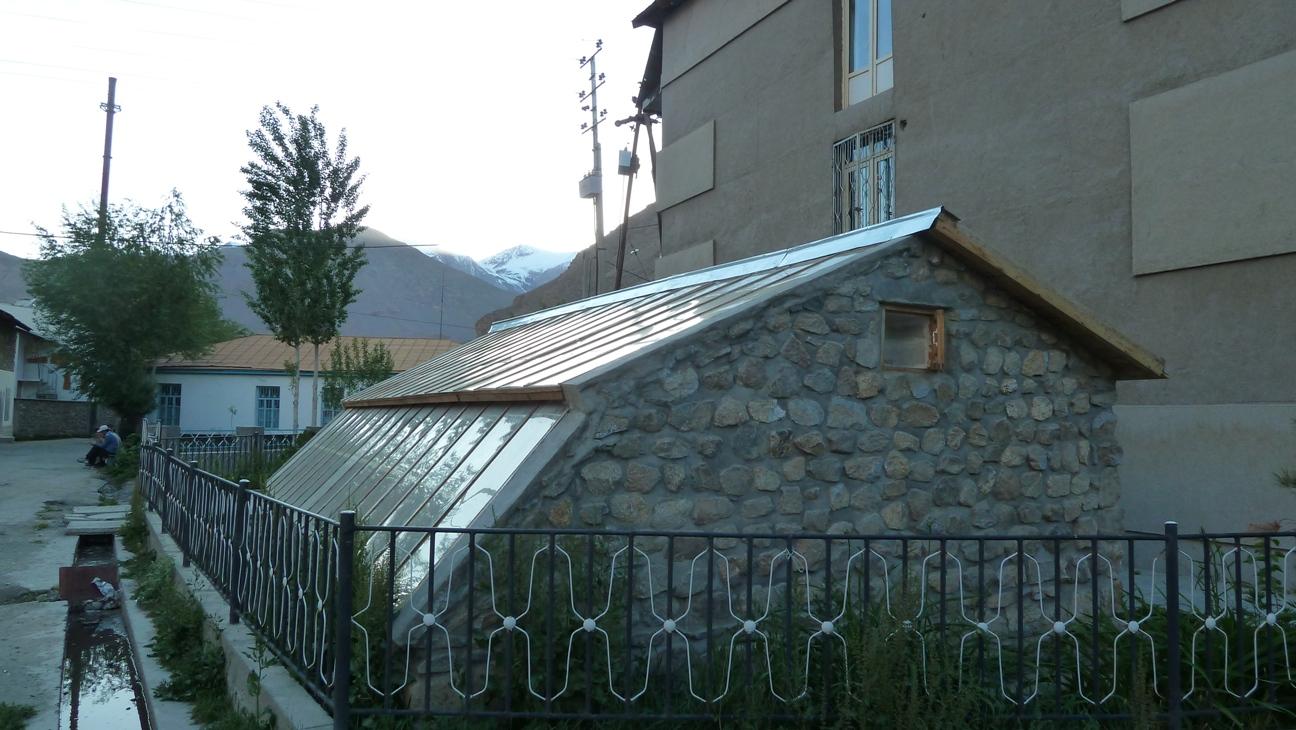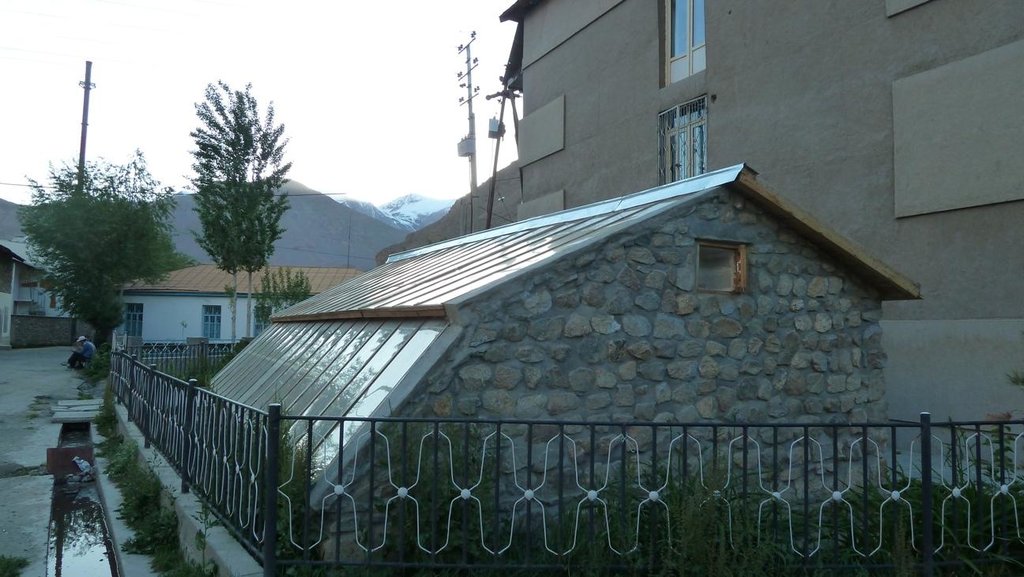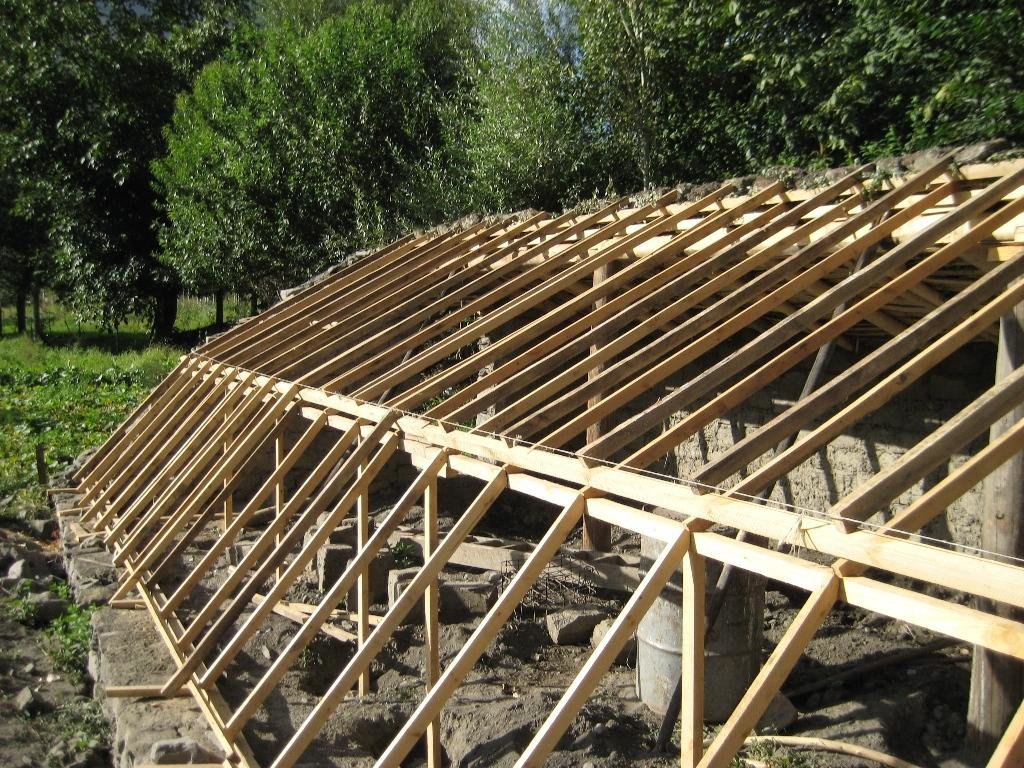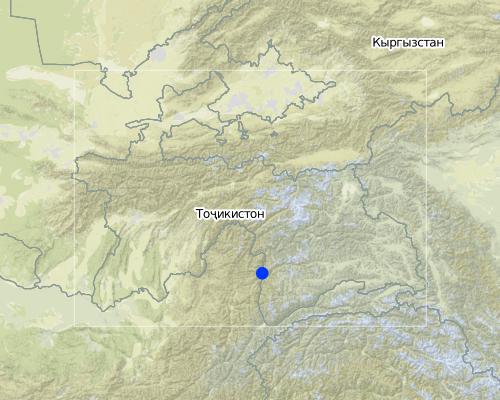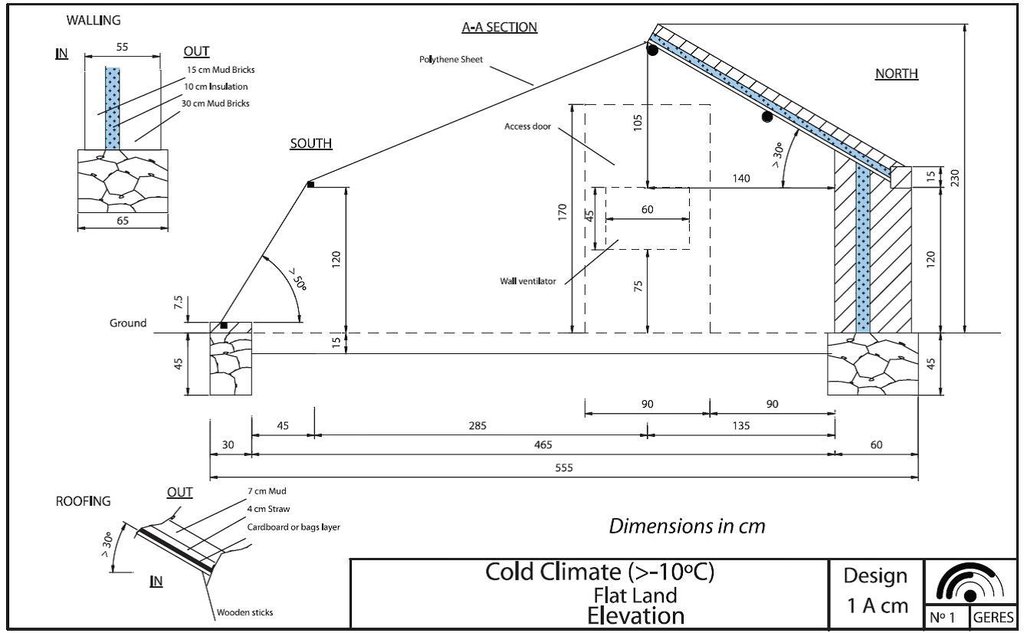Passive solar greenhouses for winter commercial vegetable production [Tajiquistão]
- Criação:
- Atualização:
- Compilador/a: Julie Zähringer
- Editor: –
- Revisor: David Streiff
technologies_1041 - Tajiquistão
- Resumo completo em PDF
- Resumo completo em PDF para impressão
- Resumo completo no navegador
- Resumo completo (sem formatação)
- Passive solar greenhouses for winter commercial vegetable production: 21 de Março de 2017 (inactive)
- Passive solar greenhouses for winter commercial vegetable production: 28 de Julho de 2017 (inactive)
- Passive solar greenhouses for winter commercial vegetable production: 19 de Agosto de 2019 (inactive)
- Passive solar greenhouses for winter commercial vegetable production: 2 de Novembro de 2021 (public)
Veja as seções
Expandir tudo Recolher tudo1. Informação geral
1.2 Detalhes do contato das pessoas capacitadas e instituições envolvidas na avaliação e documentação da tecnologia
Especialista em GST:
Khudonazarov Artur
artur.khudonazarov@yahoo.com
Manager of the "Centre for Sustainable and Innovative Technology", a project of MSDSP
Tajiquistão
Especialista em GST:
Shariff Jamil
jamil.shariff@akdn.org
MSDSP
Nome da(s) instituição(ões) que facilitou(ram) a documentação/ avaliação da Tecnologia (se relevante)
Kyrgyzstan Mountain Societies Development Support Programme, Aga Khan Development Network (MSDSP KG) - Quirguizistão1.3 Condições em relação ao uso da informação documentada através de WOCAT
Quando os dados foram compilados (no campo)?
13/05/2011
O/a compilador/a e a(s) pessoa(s) capacitada(s) aceitam as condições relativas ao uso de dados documentados através da WOCAT:
Sim
2. Descrição da tecnologia de GST
2.1 Descrição curta da tecnologia
Definição da tecnologia:
Passive solar greenhouses heated entirely by sunlight were established with the aim to produce vegetables for commercial use during the harsh winter conditions.
2.2 Descrição detalhada da tecnologia
Descrição:
A passive solar greenhouse is a greenhouse heated entirely by sunlight, with no additional fuel-based heating. In the Pamirs, the temperature inside these greenhouses can be kept high enough to grow vegetables throughout the year, even in winter if the greenhouse is built efficiently. Thus greenhouses can be of great use, particularly in those areas where there are continuing concerns about food security and economic development. These greenhouses were developed by GERES (Renewable Energy and Environment Group) and ICIMOD (International Centre for Integrated Mountain Development) and first tested with farmers in Ladakh, India. MSDSP adopted the idea and introduced it to the GBAO region in Tajikistan establishing 3 demonstration greenhouses in collaboration with farmers in the Shugnan district in 2010.
Purpose of the Technology: A solar greenhouse aims to trap and intensify the heating effect of solar radiation and thus enables plants to be grown that cannot be grown under the normal (outside) ambient conditions. Solar greenhouses are particularly useful in areas where there is a lot of sunshine in winter, but where the air is too cold for growing crops. The main benefits of solar greenhouses are that vegetables can be grown during the winter, helping to fulfill basic subsistence needs of people in remote areas and income generation through selling the produce.
Establishment / maintenance activities and inputs: A greenhouse is only efficient if it is constructed in the right place, in the right way, and is used properly. An efficient solar greenhouse should be designed along an east-west axis, with the length of the south face increased and angled to present the largest possible surface area to the sun, the size of the east and west facing walls reduced to minimise heat loss and provide shade inside the greenhouse, and the north wall should be heavily insulated.
The following steps are required in constructing an efficient greenhouse: (1) selecting an appropriate place: there needs to be a source of running water close to the greenhouse, solar radiation needs to be sufficient (sunrise should be before 9.30 and sunset after 3.00 pm even on the shortest days of the year), the land has to be flat and dry; (2) selecting the most appropriate design: (see manual); (3) constructing the foundation: digging a trench and filling the foundation with mud mortar; (4) preparing the floor; (5) building the double walls separated by one insulation layer; (6) making and installing an access door; (7) making and installing the wall ventilator; (8) constructing the roof; (9) making and installing the roof ventilator (shutter); (10) installing the polyethylene shutter; (11) installing night insulation.
Natural / human environment: The greenhouses were established in three villages of Shugnan district: Buni, Sokhcharv and Darmoracht. Two of these villages are located at about 2,500 metres a.s.l. and receive less than 300 mm of annual precipitation. The farmers who constructed these greenhouses are small-scale farmers with less than 0.5 ha of land available.
2.3 Fotos da tecnologia
2.5 País/região/locais onde a tecnologia foi aplicada e que estão cobertos nesta avaliação
País:
Tajiquistão
Região/Estado/Província:
Tajikistan
Especificação adicional de localização:
GBAO/Shugnan
Map
×2.6 Data da implementação
Caso o ano exato seja desconhecido, indique a data aproximada:
- menos de 10 anos atrás (recentemente)
2.7 Introdução da tecnologia
Especifique como a tecnologia foi introduzida:
- através de projetos/intervenções externas
Comentários (tipos de projeto, etc.):
2010
3. Classificação da tecnologia de GST
3.1 Principal/principais finalidade(s) da tecnologia
- Melhora a produção
3.2 Tipo(s) atualizado(s) de uso da terra onde a tecnologia foi aplicada

Terra de cultivo
- Cultura anual
Principais plantações (colheitas para venda e consumo próprio):
Major food crop: Cucumbers, tomatoes, radishes, salad greens, onions
Other: In the greenhouse (for commercial purposes)

Assentamentos, infraestrutura
- Assentamentos, edificações
Comentários:
Major land use problems (compiler’s opinion): A lack of precipitation and therefore irrigation water, soil erosion, low soil fertility (no fertilisers used or rotations), harsh climatic conditions (high altitude).
Future (final) land use (after implementation of SLM Technology): Cropland: Ca: Annual cropping
Caso o uso da terra tenha mudado devido a implementação da tecnologia, indique seu uso anterior à implementação da tecnologia:
Other: Os: Settlements, infrastructure networks
3.3 Mais informações sobre o uso da terra
Abastecimento de água para a terra na qual a tecnologia é aplicada:
- Irrigação completa
Número de estações de cultivo por ano:
- 1
Especifique:
Longest growing period in days: 170Longest growing period from month to month: late April-early October
3.4 Grupo de GST ao qual pertence a tecnologia
- Hortas familiares
- greenhouse
3.5 Difusão da tecnologia
Comentários:
At least 3 greenhouses built in Shugnan district, each one is 50 m2 in size.
3.6 Medidas de GST contendo a tecnologia

Medidas agronômicas
- A2: Matéria orgânica/fertilidade do solo

Medidas estruturais
- S11: Outros
Comentários:
Main measures: agronomic measures, structural measures
Type of agronomic measures: manure / compost / residues
3.7 Principais tipos de degradação da terra abordados pela tecnologia

Deteriorização química do solo
- Cn: declínio de fertilidade e teor reduzido de matéria orgânica (não causado pela erosão)

Degradação biológica
- Bq: quantidade/ declínio da biomassa
- Bs: Qualidade e composição de espécies/declínio de diversidade
Comentários:
Main type of degradation addressed: Cn: fertility decline and reduced organic matter content, Bq: quantity / biomass decline, Bs: quality and species composition /diversity decline
Main causes of degradation: soil management (no application of fertilisers), deforestation / removal of natural vegetation (incl. forest fires), overgrazing, change of seasonal rainfall (decreased), droughts
Secondary causes of degradation: war and conflicts (during the civil war a lot of vegetation was cut to provide energy)
3.8 Redução, prevenção ou recuperação da degradação do solo
Especifique o objetivo da tecnologia em relação a degradação da terra:
- Prevenir degradação do solo
4. Especificações técnicas, implementação de atividades, entradas e custos
4.1 Desenho técnico da tecnologia
4.2 Especificações técnicas/ explicações do desenho técnico
The diagram shows a greenhouse adapted to a cold climate, for greenhouses adapted to different climates please see the manual (annex 1)
GBAO
Date: 2004
Technical knowledge required for field staff / advisors: high
Technical knowledge required for land users: moderate (brochures available in Tajik)
Main technical functions: increase in organic matter, reduction in wind speed, increase of biomass (quantity), spatial arrangement and diversification of land use, production of microclimate suitable for crop growth in winter
Manure / compost / residues
Material/ species: manure is mixed with the soil to cover the floor of the greenhouse
Structural measure: greenhouse
Construction material (earth): mud
Construction material (stone): stone
Construction material (wood): wood (poplar, willow)
Construction material (other): straw, wool
4.3 Informação geral em relação ao cálculo de entradas e custos
Outro/moeda nacional (especifique):
Somoni
Indique a taxa cambial do dólar norte americano para a moeda local (se relevante): 1 USD =:
4,5
Indique a média salarial da mão-de-obra contratada por dia:
9.00
4.4 Atividades de implantação
| Atividade | Tipo de medida | Periodicidade | |
|---|---|---|---|
| 1. | Digging trench for fundament, 60 cm deep | Estrutural | spring |
| 2. | Put fundament using stones mixed with mud | Estrutural | |
| 3. | Build walls: outer layer stones (40 cm width), then insulation layer with straw or wool (10 cm), inner layer out of mudbricks (15-20 cm). Total height of wall is 1.20 m. | Estrutural | |
| 4. | Build doors | Estrutural | |
| 5. | Build wall ventilators | Estrutural | |
| 6. | Build roof: southfacing side put 2 layers of each 40m2 cellophane, northfacing side put woodlogs | Estrutural | |
| 7. | Build roof ventilators | Estrutural | |
| 8. | Install night insulation | Estrutural |
4.5 Custos e entradas necessárias para a implantação
| Especifique a entrada | Unidade | Quantidade | Custos por unidade | Custos totais por entrada | % dos custos arcados pelos usuários da terra | |
|---|---|---|---|---|---|---|
| Mão-de-obra | Digging trench for fundament, | Persons/day | 3,0 | 40,0 | 120,0 | 100,0 |
| Mão-de-obra | Put fundament | Persons/day | 10,5 | 40,0 | 420,0 | 100,0 |
| Mão-de-obra | Build walls | Persons/day | 30,0 | 40,0 | 1200,0 | 100,0 |
| Mão-de-obra | Build doors | Persons/day | 2,0 | 20,0 | 40,0 | 100,0 |
| Equipamento | Shovels | Pieces | 2,0 | 20,0 | 40,0 | 100,0 |
| Equipamento | Nails | kg | 3,0 | 10,0 | 30,0 | |
| Material de construção | Cellophane foil | sq m | 80,0 | 4,0 | 320,0 | |
| Outros | Labour: Build wall ventilators | Persons/day | 12,0 | 40,0 | 480,0 | 100,0 |
| Outros | Labour: Build roof ventilators | Persons/day | 4,0 | 40,0 | 160,0 | 100,0 |
| Outros | Labour: Install night insulation | Persons/day | 5,0 | 40,0 | 200,0 | 100,0 |
| Custos totais para a implantação da tecnologia | 3010,0 | |||||
Se o usuário da terra arca com menos que 100% dos custos, indique quem cobre os custos remanescentes:
MSDSP
Comentários:
Duration of establishment phase: 1.5 month(s)
4.6 Atividades recorrentes/manutenção
| Atividade | Tipo de medida | Periodicidade/frequência | |
|---|---|---|---|
| 1. | Replace cellophane | Estrutural | when needed, every 1-2 years for bad material, 5 years for good material |
4.7 Custos e entradas necessárias pata a manutenção/atividades recorrentes (por ano)
| Especifique a entrada | Unidade | Quantidade | Custos por unidade | Custos totais por entrada | % dos custos arcados pelos usuários da terra | |
|---|---|---|---|---|---|---|
| Mão-de-obra | Replace cellophane | Persons/day | 2,0 | 40,0 | 80,0 | 100,0 |
| Material de construção | Cellophane | sq m | 80,0 | 4,0 | 320,0 | 100,0 |
| Custos totais para a manutenção da tecnologia | 400,0 | |||||
Comentários:
The costs were calculated for the establishment of one 5x10m greenhouse.
4.8 Fatores mais importantes que afetam os custos
Descreva os fatores mais determinantes que afetam os custos:
Apart from the cellophane cover, mainly local materials were used which did not require investments. If labour has to be paid, this is the most determinate factor, also wooden poles if they have to be bought.
5. Ambiente natural e humano
5.1 Clima
Precipitação pluviométrica anual
- <250 mm
- 251-500 mm
- 501-750 mm
- 751-1.000 mm
- 1.001-1.500 mm
- 1.501-2.000 mm
- 2.001-3.000 mm
- 3.001-4.000 mm
- > 4.000 mm
Especificações/comentários sobre a pluviosidade:
200-300 mm
Zona agroclimática
- Árido
Thermal climate class: temperate
5.2 Topografia
Declividade média:
- Plano (0-2%)
- Suave ondulado (3-5%)
- Ondulado (6-10%)
- Moderadamente ondulado (11-15%)
- Forte ondulado (16-30%)
- Montanhoso (31-60%)
- Escarpado (>60%)
Formas de relevo:
- Planalto/planície
- Cumes
- Encosta de serra
- Encosta de morro
- Sopés
- Fundos de vale
Zona de altitude:
- 0-100 m s.n.m.
- 101-500 m s.n.m.
- 501-1.000 m s.n.m.
- 1.001-1.500 m s.n.m.
- 1.501-2.000 m s.n.m.
- 2.001-2.500 m s.n.m.
- 2.501-3.000 m s.n.m.
- 3.001-4.000 m s.n.m.
- > 4.000 m s.n.m.
Comentários e outras especificações sobre a topografia:
Landforms: plateau / plains, hill slopes, footslopes, valley floors
5.3 Solos
Profundidade do solo em média:
- Muito raso (0-20 cm)
- Raso (21-50 cm)
- Moderadamente profundo (51-80 cm)
- Profundo (81-120 cm)
- Muito profundo (>120 cm)
Textura do solo (solo superficial):
- Grosso/fino (arenoso)
Matéria orgânica do solo superficial:
- Baixo (<1%)
Caso disponível anexe a descrição completa do solo ou especifique as informações disponíveis, p. ex. tipo de solo, PH/acidez do solo, nitrogênio, capacidade de troca catiônica, salinidade, etc.
Soil fertility is low
Soil drainage / infiltration is medium
Soil water storage capacity is medium
5.4 Disponibilidade e qualidade de água
Lençol freático:
< 5 m
Disponibilidade de água de superfície:
Bom
Qualidade da água (não tratada):
Água potável precária (tratamento necessário)
Comentários e outras especificações sobre a qualidade e a quantidade da água:
Water availability is good because area is close to river.
5.5 Biodiversidade
Diversidade de espécies:
- Baixo
5.6 Características dos usuários da terra que utilizam a tecnologia
Orientação de mercado do sistema de produção:
- Misto (subsistência/comercial)
- Comercial/mercado
Rendimento não agrícola:
- Menos de 10% de toda renda
Nível relativo de riqueza:
- Média
Indivíduos ou grupos:
- Indivíduo/unidade familiar
Nível de mecanização:
- Tração animal
- Mecanizado/motorizado
Gênero:
- Mulheres
- Homens
Indique outras características relevantes dos usuários da terra:
Land users applying the Technology are mainly common / average land users
5.7 Média da área de terra própria ou arrendada por usuários da terra que utilizam a tecnologia
- < 0,5 ha
- 0,5-1 ha
- 1-2 ha
- 2-5 ha
- 5-15 ha
- 15-50 ha
- 50-100 ha
- 100-500 ha
- 500-1.000 ha
- 1.000-10.000 ha
- > 10.000 ha
É considerado pequena, média ou grande escala (referente ao contexto local)?
- Pequena escala
5.8 Propriedade de terra, direitos de uso da terra e de uso da água
Propriedade da terra:
- Estado
- Indivíduo, intitulado
Direitos do uso da terra:
- Indivíduo
5.9 Acesso a serviços e infraestrutura
Saúde:
- Pobre
- Moderado
- Bom
Educação:
- Pobre
- Moderado
- Bom
Assistência técnica:
- Pobre
- Moderado
- Bom
Emprego (p. ex. não agrícola):
- Pobre
- Moderado
- Bom
Mercados:
- Pobre
- Moderado
- Bom
Energia:
- Pobre
- Moderado
- Bom
Vias e transporte:
- Pobre
- Moderado
- Bom
Água potável e saneamento:
- Pobre
- Moderado
- Bom
Serviços financeiros:
- Pobre
- Moderado
- Bom
6. Impactos e declarações finais
6.1 Impactos no local mostrados pela tecnologia
Impactos socioeconômicos
Produção
Produção agrícola
Risco de falha de produção
Área de produção
Renda e custos
Rendimento agrícola
Diversidade de fontes de rendimento
Carga de trabalho
Comentários/especificar:
During construction of the greenhouse, 6 weeks
Outros impactos socioeconômicos
Establishment costs
Comentários/especificar:
high investment (400 $ for 1 greenhouse)
Impactos socioculturais
Segurança alimentar/auto-suficiência
Estado de saúde
Livelihood and human well-being
Comentários/especificar:
Higher income and better health through availability of vegetables in the winter
Impactos ecológicos
Outros impactos ecológicos
Creation of microclimate for growing vegetables during wintertime
6.2 Impactos externos mostrados pela tecnologia
Availability of vegetables on the market during wintertime
6.3 Exposição e sensibilidade da tecnologia às mudanças climáticas graduais e extremos/desastres relacionados ao clima (conforme o ponto de vista dos usuários da terra)
Mudança climática gradual
Mudança climática gradual
| Estação do ano | Tipo de mudança climática/extremo | Como a tecnologia lida com isso? | |
|---|---|---|---|
| Temperatura anual | aumento | bem |
Extremos (desastres) relacionados ao clima
Desastres meteorológicos
| Como a tecnologia lida com isso? | |
|---|---|
| Tempestade de vento local | não bem |
Desastres climatológicos
| Como a tecnologia lida com isso? | |
|---|---|
| Seca | não bem |
Outras consequências relacionadas ao clima
Outras consequências relacionadas ao clima
| Como a tecnologia lida com isso? | |
|---|---|
| Período de crescimento reduzido | bem |
6.4 Análise do custo-benefício
Como os benefícios se comparam aos custos de implantação (do ponto de vista dos usuários da terra)?
Retornos a curto prazo:
levemente positivo
Retornos a longo prazo:
muito positivo
Como os benefícios se comparam aos custos recorrentes/de manutenção(do ponto de vista dos usuários da terra)?
Retornos a curto prazo:
levemente positivo
Retornos a longo prazo:
muito positivo
Comentários:
Income revenues from vegetables are high, during one winter season two yields of vegetables can be planted.
6.5 Adoção da tecnologia
- casos isolados/experimental
Se disponível, determine a quantidade (número de unidades familiares e/ou área abordada):
3 households
Entre todos aqueles que adotaram a tecnologia, quantos adotaram espontaneamente, ou seja, sem receber nenhum incentivo material/pagamentos?
- 0-10%
Comentários:
100% of land user families have adopted the Technology with external material support
3 land user families have adopted the Technology with external material support
There is a strong trend towards spontaneous adoption of the Technology
Comments on adoption trend: many land users who have seen the demonstration greenhouses want to start constructing their own.
6.7 Pontos fortes/vantagens/oportunidades da tecnologia
| Pontos fortes/vantagens/oportunidades na visão do usuário da terra |
|---|
|
The materials are locally available (mud, wood, straw, stone), except for the transparent cover sheet How can they be sustained / enhanced? Some traders should start providing transparent foil |
|
Using the available construction manual it can be constructed by local builders How can they be sustained / enhanced? The local builders still need to be advised by specialists |
|
The cost can be recouped in less than three years if the production is well-managed and the products sold |
| Pontos fortes/vantagens/oportunidades na visão do/a compilador/a ou de outra pessoa capacitada |
|---|
|
Vegetable production during wintertime and diversified food production all year round How can they be sustained / enhanced? Farmers should have access to microloan organisations in order to be able to invest in building greenhouses (initial investments are relatively high) |
|
Availability of vegetables during wintertime, otherwise they have to be brought in from the capital (600 km by road) which makes them very expensive How can they be sustained / enhanced? Greenhouses should be distributed over the whole of GBAO in order to ensure local availability of crops, because during wintertime transport might be a big problem |
|
Income opportunity How can they be sustained / enhanced? Better access to markets would improve profitability |
|
Minimal heat loss, heat is stored during the day time and released at night How can they be sustained / enhanced? The greenhouse and should be constructed in a very careful and exact manner in order to make sure that the inside temperature can be well regulated |
|
Adequate air circulation and prevention of crop damage by overheating, through installation of manually operated ventilators in walls and roof How can they be sustained / enhanced? Farmers need access to specialists who will help them in designing greenhouses appropriate to the prevailing ecological conditions |
6.8 Pontos fracos, desvantagens/riscos da tecnologia e formas de superá-los
| Pontos fracos/vantagens/riscos na visão do/a compilador/a ou de outra pessoa capacitada | Como eles podem ser superados? |
|---|---|
| Comparatively expensive, about 400 USD have to be invested for the construction of one greenhouse | The increased revenues from selling the produced vegetables can help cover the initial investment |
| Comparatively time consuming to build compared to conventional greenhouses in the area, one greenhouse needs about 6 weeks to be constructed | Plastic poles could be used instead of wooden ones |
| No good quality cellophane foil is available in this area, therefore it has to be replaced every 1-2 years | Instead of cellophane plexiglas could be used which is stronger. |
7. Referências e links
7.2 Referências às publicações disponíveis
Título, autor, ano, ISBN:
Stauffer, Vincent. Solar Greenhouses for the Trans-Himalayas. Kathmandu, ICIMOD / Aubagne, GERES 2004.
Disponível de onde? Custos?
http://books.icimod.org/index.php/search/publication/93
Links e módulos
Expandir tudo Recolher tudoLinks
Não há links
Módulos
Não há módulos


